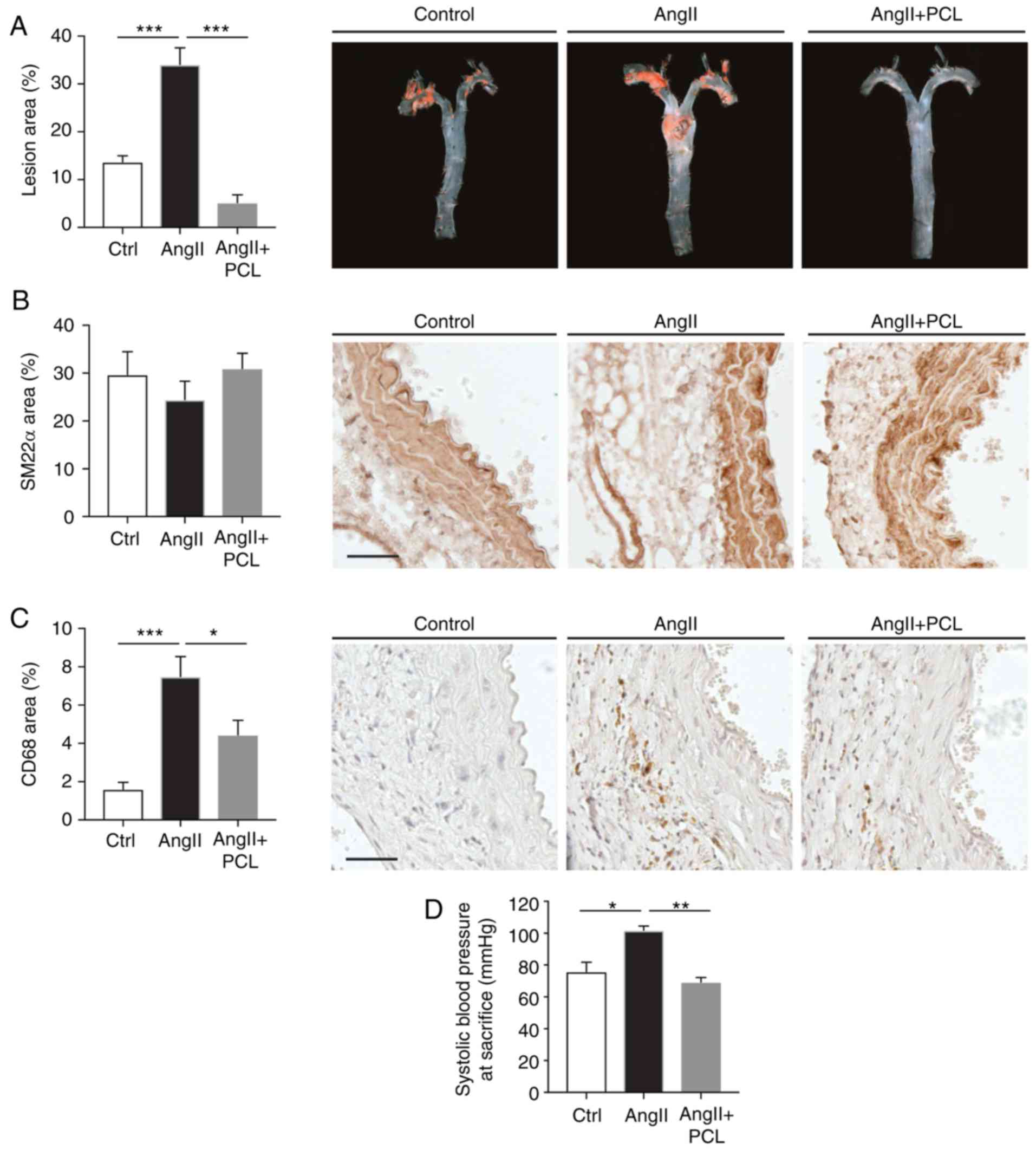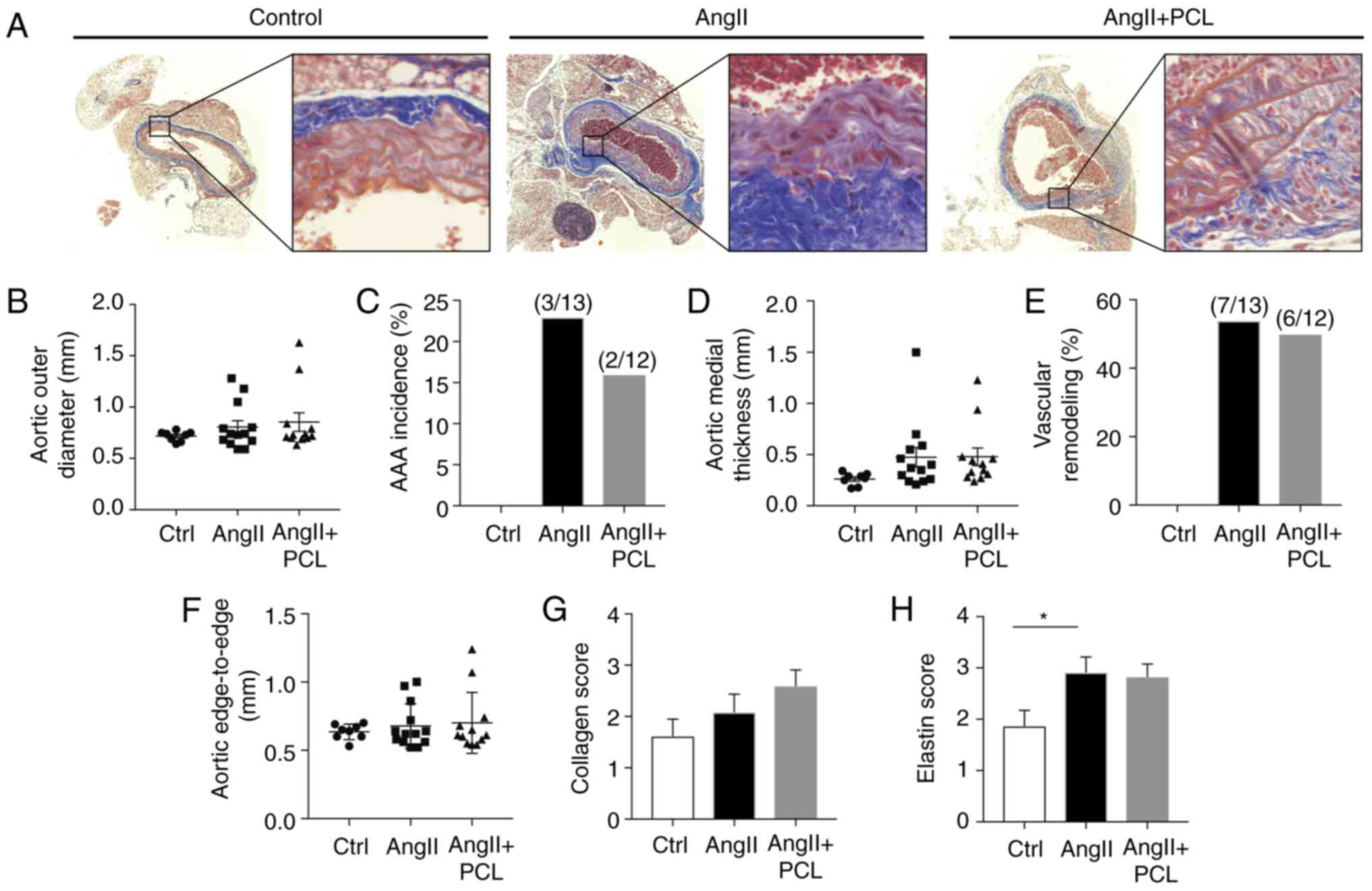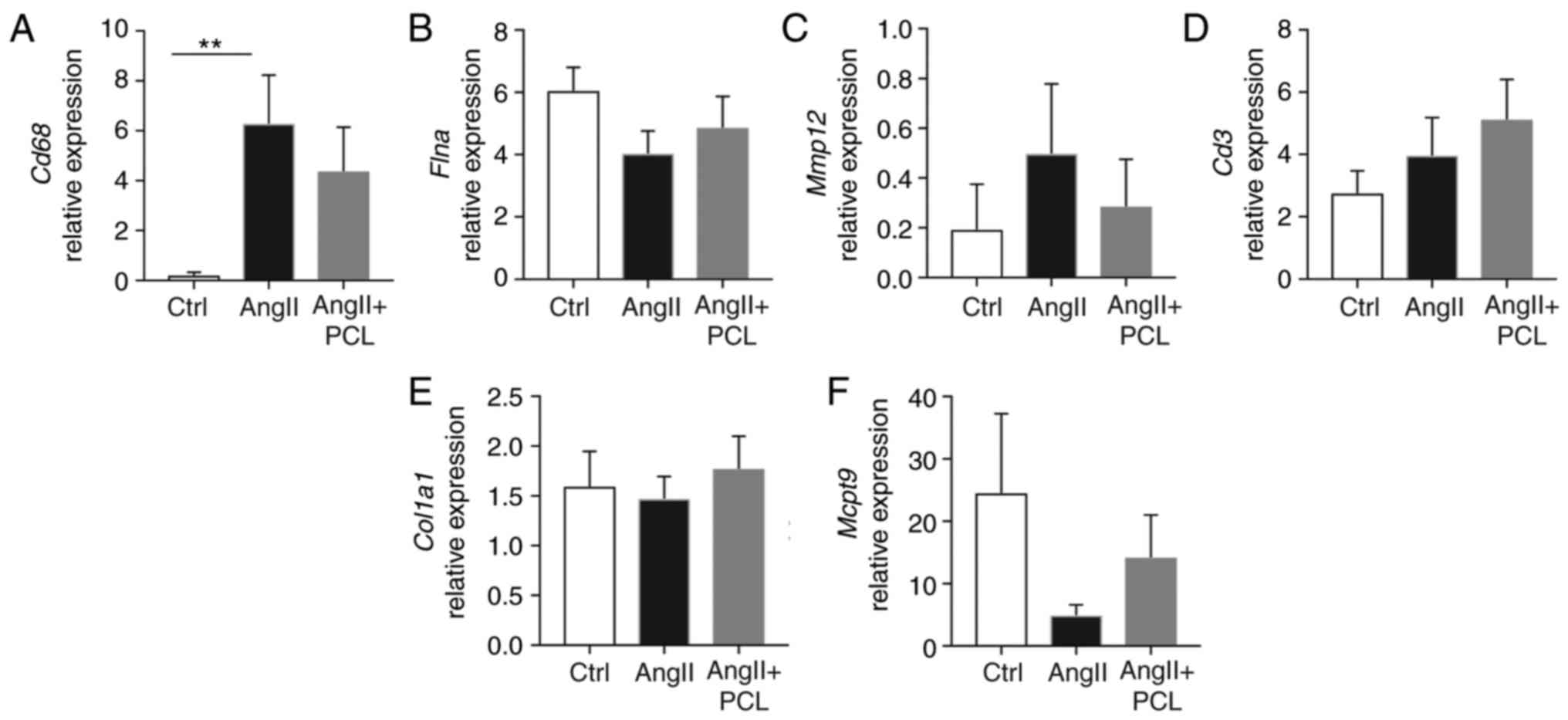|
1
|
Toghill BJ, Saratzis A and Bown MJ:
Abdominal aortic aneurysm-an independent disease to
atherosclerosis? Cardiovasc Pathol. 27:71–75. 2017. View Article : Google Scholar : PubMed/NCBI
|
|
2
|
Kuivaniemi H, Ryer EJ, Elmore JR and Tromp
G: Understanding the pathogenesis of abdominal aortic aneurysms.
Expert Rev Cardiovasc Ther. 13:975–987. 2015. View Article : Google Scholar : PubMed/NCBI
|
|
3
|
Wahlgren CM, Larsson E, Magnusson PK,
Hultgren R and Swedenborg J: Genetic and environmental
contributions to abdominal aortic aneurysm development in a twin
population. J Vasc Surg. 51:3–7. 2010. View Article : Google Scholar
|
|
4
|
Peshkova IO, Schaefer G and Koltsova EK:
Atherosclerosis and aortic aneurysm-is inflammation a common
denominator? FEBS J. 283:1636–1652. 2016. View Article : Google Scholar
|
|
5
|
Tabas I, García-Cardeña G and Owens GK:
Recent insights into the cellular biology of atherosclerosis. J
Cell Biol. 209:13–22. 2015. View Article : Google Scholar : PubMed/NCBI
|
|
6
|
Golledge J and Norman PE: Atherosclerosis
and abdominal aortic aneurysm: Cause, response, or common risk
factors? Arterioscler Thromb Vasc Biol. 30:1075–1077. 2010.
View Article : Google Scholar : PubMed/NCBI
|
|
7
|
Steinmetz EF, Buckley C, Shames ML, Ennis
TL, Vanvickle-Chavez SJ, Mao D, Goeddel LA, Hawkins CJ and Thompson
RW: Treatment with simvastatin suppresses the development of
experimental abdominal aortic aneurysms in normal and
hypercholesterolemic mice. Ann Surg. 241:92–101. 2005.
|
|
8
|
Kalyanasundaram A, Elmore JR, Manazer JR,
Golden A, Franklin DP, Galt SW, Zakhary EM and Carey DJ:
Simvastatin suppresses experimental aortic aneurysm expansion. J
Vasc Surg. 43:117–124. 2006. View Article : Google Scholar
|
|
9
|
van der Meij E, Koning GG, Vriens PW,
Peeters MF, Meijer CA, Kortekaas KE, Dalman RL, van Bockel JH,
Hanemaaijer R, Kooistra T, et al: A clinical evaluation of statin
pleiotropy: Statins selectively and dose-dependently reduce
vascular inflammation. PLoS One. 8:e538822013. View Article : Google Scholar : PubMed/NCBI
|
|
10
|
Takagi H, Yamamoto H, Iwata K, Goto S and
Umemoto T; ALICE (All-Literature Investigation of Cardiovascular
Evidence) Group: Effects of statin therapy on abdominal aortic
aneurysm growth: A meta-analysis and meta-regression of
observational comparative studies. Eur J Vasc Endovasc Surg.
44:287–292. 2012. View Article : Google Scholar : PubMed/NCBI
|
|
11
|
Twine CP and Williams IM: Systematic
review and meta-analysis of the effects of statin therapy on
abdominal aortic aneurysms. Br J Surg. 98:346–353. 2011. View Article : Google Scholar : PubMed/NCBI
|
|
12
|
Wemmelund H, Hogh A, Hundborg HH, Thomsen
RW, Johnsen SP and Lindholt JS: Statin use and rupture of abdominal
aortic aneurysm. Br J Surg. 101:966–975. 2014. View Article : Google Scholar : PubMed/NCBI
|
|
13
|
Björkegren JL, Hägg S, Talukdar HA,
Foroughi Asl H, Jain RK, Cedergren C, Shang MM, Rossignoli A,
Takolander R, Melander O, et al: Plasma cholesterol-induced lesion
networks activated before regression of early, mature, and advanced
atherosclerosis. PLoS Genet. 10:e10042012014. View Article : Google Scholar : PubMed/NCBI
|
|
14
|
Rossignoli A, Shang MM, Gladh H,
Moessinger C, Foroughi Asl H, Talukdar HA, Franzén O, Mueller S,
Björkegren JL, Folestad E, et al: Poliovirus receptor-related 2: A
cholesterol-responsive gene affecting atherosclerosis development
by modulating leukocyte migration. Arterioscler Thromb Vasc Biol.
37:534–542. 2017. View Article : Google Scholar : PubMed/NCBI
|
|
15
|
Deng GG, Martin-McNulty B, Sukovich DA,
Freay A, Halks-Miller M, Thinnes T, Loskutoff DJ, Carmeliet P, Dole
WP and Wang YX: Urokinase-type plasminogen activator plays a
critical role in angiotensin II-induced abdominal aortic aneurysm.
Circ Res. 92:510–517. 2003. View Article : Google Scholar : PubMed/NCBI
|
|
16
|
Skogsberg J, Lundström J, Kovacs A,
Nilsson R, Noori P, Maleki S, Köhler M, Hamsten A, Tegnér J and
Björkegren J: Transcriptional profiling uncovers a network of
cholesterol-responsive atherosclerosis target genes. PLoS Genet.
4:e10000362008. View Article : Google Scholar : PubMed/NCBI
|
|
17
|
Assessment of health status of small
rodents and rabbits when illness is suspected. Journal. 2015.
|
|
18
|
Extended assessment of health status of
small rodents and rabbits postoperatively or when necessary.
Journal. 2015.
|
|
19
|
Larionov A, Krause A and Miller W: A
standard curve based method for relative real time PCR data
processing. BMC Bioinformatics. 6:622005. View Article : Google Scholar : PubMed/NCBI
|
|
20
|
Veniant MM, Sullivan MA, Kim SK, Ambroziak
P, Chu A, Wilson MD, Hellerstein MK, Rudel LL, Walzem RL and Young
SG: Defining the atherogenicity of large and small lipoproteins
containing apolipoprotein B100. J Clin Invest. 106:1501–1510. 2000.
View Article : Google Scholar : PubMed/NCBI
|
|
21
|
Gladh H, Folestad EB, Muhl L, Ehnman M,
Tannenberg P, Lawrence AL, Betsholtz C and Eriksson U: Mice lacking
platelet-derived growth factor D display a mild vascular phenotype.
PLoS One. 11:e01522762016. View Article : Google Scholar : PubMed/NCBI
|
|
22
|
Longo GM, Buda SJ, Fiotta N, Xiong W,
Griener T, Shapiro S and Baxter BT: MMP-12 has a role in abdominal
aortic aneurysms in mice. Surgery. 137:457–462. 2005. View Article : Google Scholar : PubMed/NCBI
|
|
23
|
Daugherty A and Cassis LA: Mouse models of
abdominal aortic aneurysms. Arterioscler Thromb Vasc Biol.
24:429–434. 2004. View Article : Google Scholar : PubMed/NCBI
|
|
24
|
Daugherty A, Manning MW and Cassis LA:
Angiotensin II promotes atherosclerotic lesions and aneurysms in
apolipoprotein E-deficient mice. J Clin Invest. 105:1605–1612.
2000. View Article : Google Scholar
|
|
25
|
Cassis LA, Marshall DE, Fettinger MJ,
Rosenbluth B and Lodder RA: Mechanisms contributing to angiotensin
II regulation of body weight. Am J Physiol. 274:E867–E876.
1998.PubMed/NCBI
|
|
26
|
Qin Z, Bagley J, Sukhova G, Baur WE, Park
HJ, Beasley D, Libby P, Zhang Y and Galper JB: Angiotensin
II-induced TLR4 mediated abdominal aortic aneurysm in
apolipoprotein E knockout mice is dependent on STAT3. J Mol Cell
Cardiol. 87:160–170. 2015. View Article : Google Scholar : PubMed/NCBI
|
|
27
|
Thatcher SE, Zhang X, Howatt DA,
Yiannikouris F, Gurley SB, Ennis T, Curci JA, Daugherty A and
Cassis LA: Angiotensin-converting enzyme 2 decreases formation and
severity of angiotensin II-induced abdominal aortic aneurysms.
Arterioscler Thromb Vasc Biol. 34:2617–2623. 2014. View Article : Google Scholar : PubMed/NCBI
|
|
28
|
Liu J, Lu H, Howatt DA, Balakrishnan A,
Moorleghen JJ, Sorci-Thomas M, Cassis LA and Daugherty A:
Associations of ApoAI and ApoB-containing lipoproteins with
AngII-induced abdominal aortic aneurysms in mice. Arterioscler
Thromb Vasc Biol. 35:1826–1834. 2015. View Article : Google Scholar : PubMed/NCBI
|
|
29
|
Ailawadi G, Moehle CW, Pei H, Walton SP,
Yang Z, Kron IL, Lau CL and Owens GK: Smooth muscle phenotypic
modulation is an early event in aortic aneurysms. J Thorac
Cardiovasc Surg. 138:1392–1399. 2009. View Article : Google Scholar : PubMed/NCBI
|













